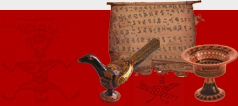| 您的位置:首页 --> 与会学者 --> 论文提要 |
彝族毕摩插枝仪式中数学知识的应用
The Function of Mathematical Concepts
in the Arrangement of Sacred Sticks and Branches in Bimo Ritual
阿牛木支 Aniu Muzhi
西昌学院彝文系
【摘要】彝族毕摩文化艺术形态中,描绘仪式场所的插枝图就有一百多种。这些插枝图依据具体法事进行布阵,其形式异彩纷呈,结构错综复杂,很难被人理解。我们扬弃其迷信成分,只纯粹从数学角度逐一辨析。在算术方面,其“以一而九,反本归一,以生倍数”的数理起源,特别是用数项级数求有限和的“消患仪式插枝图”及应用奇偶性确定分检竹条数目的占卜卦算等形式中的数理逻辑是相当有趣和明晰的。在几何图形方面,净灵仪式场中的插枝图以中间小长方形为中心,四方构成了对称的几何图形,展示了数学的对称美。训导仪式中的内位核心图围成一个椭圆形,中间三种符号说明了该椭圆图形树枝数及其插枝的过程。同时,从该椭圆图中也可以看出,彝族毕摩对基本几何图形的巧妙组合能力,已达到较高的艺术境界。祝福仪式中的插枝图构成一个矩形,让四角的四簇树枝数目分别对应相等,充分显示出对称性、均衡美和稳重感,给人以直观的平面视觉效果。彝族毕摩从事宗教活动中,都要通过插枝仪式,达到与神灵沟通,帮助人们驱凶除祸,祈福吉祥、安康的目的。从表面上看,这是隶属封建迷信思想,透过实质加以考察、分析,却深深潜藏着天文、算数和几何方面的诸多科学思想。由此而来,彝族毕摩插枝仪式活动既是数码游戏网络和运算法则的简单描摹,又是各种几何图形能力的传承和延拓。
关键词: 彝族 毕摩 插枝仪式 图解 数学
Abstract
There are over 100 kinds of sacred sticks and branches diagrams
illustrating ritual settings practiced in bimo cultural and artistic
forms of the Yi People. The making of these sacred diagrams is
profound with complicated structures; most remain a puzzle to
be understood. Now, we reveal the mysterious mask of their composition,
analyzing them from a purely mathematical perspective. In arithmetic,
these diagrams, especially the illustration of Dispelling Disaster
Ritual and Divination are very fascinating and unique. In geometry,
there are all kinds of figures in these pictures. For example,
the diagram of Purifying Soul Ritual makes the center with small
rectangle, the internal core pattern of teaching and guiding ritual
forms an ellipse, the diagram of Blessing Ritual constitutes a
rectangle, and the middle line is the reflecting axis in the diagram
of Eliminating Filth Ritual. When Bimo perform religions activities,
they can communicate with gods and ghosts, help people keep away
from disaster and misfortune, pray for luck and health through
all kinds of rituals. Looking at the surface of them, the origins
of the rituals are obscure. But analyzing their essence, we can
find that they contain a lot of concepts from sciences such as
astronomy, arithmetic, geometry etc. So the ritual activities
of Yi bimo are not only a description of a net of numeral games
and computational formulas, but also maintain transmission and
continuity of geometric heritage.
Keywords: Yi People─bimo─knowledge─diagramming─mathematics
作者简介:
阿牛木支,男,彝族,1967年3月生,大学双本科学历,先后于1999、2002年两次破格晋升为副教授、教授,四川省劳动模范和十佳青年教师,四川省学术带头人后备人选,四川省作家协会会员。长期从事彝族母语文学、科技文化和民族高等教育研究。主持和主研国家、省级科研项目10项,出版专著《当代彝文文学研究》,参编教材《当代彝文文选教程》《古代彝文文选教程》等5部;发表学术论文《20世纪彝族文学概述》《彝族诗歌创作概论》《彝族数学思想及其展望》《彝族力学应用初探》等80余篇。获全国少数民族文学骏马奖、全国少数民族文学研究优秀评论奖、四川省高等教育教学成果奖、四川省巴蜀文艺奖、四川省文学奖和四川省优秀图书奖。
About the Author:
Aniu Muzhi (Anyo Murrryr), male, Nuosu Yi, was born on March,
1967. He has dual undergraduate degree and was promoted to associate
professor and professor in 1999 and in 2002. He is a labour model
and one of ten excellent young teachers of Sichuan Province, a
member of Sichuan Writers’ Association. He has carried out long-term
research on native language culture, scientific and technologic
culture and has been awarded over 10 national and provincial scientific
research grants. He has published a monograph "Yi Contemporary
Literature Research", and jointly edited 5 textbooks, including
"Research on Contemporary Yi Literature", and "Teaching
Anthology of Ancient Yi Literature," and also published over
80 academic papers such as "A summary of Yi culture in the
20th century","the Summarization of Yi poem writing,"
"Yi mathematical thoughts and prospects," "Initial
explorations of Yi mechanics application," and others. He
has reveived The Steed Award for Minority Culture," The Distinguished
Criticism Award for Minority Culture Research, The Sichuan Higher
Education and Teaching Accomplishments Award, The Bashu Literature
and Art Award of Sichuan, The Sichuan Culture Award and The Excellent
Books Award.
|





